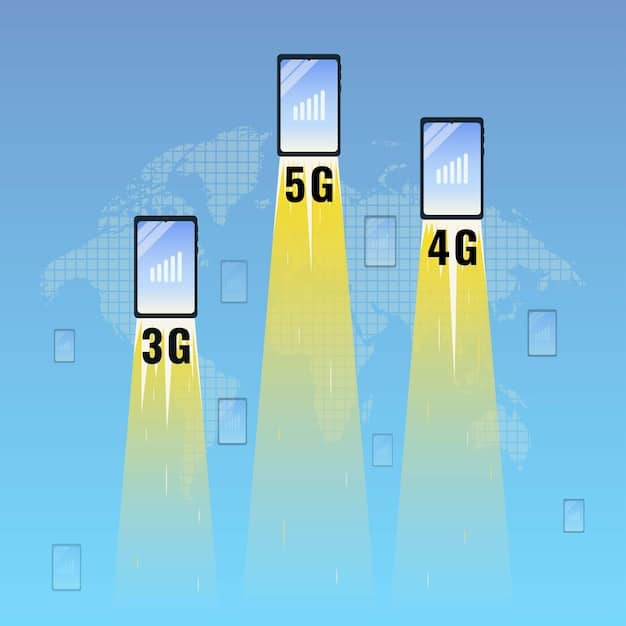5G Home Internet: Is It a Good Broadband Alternative in the US?

5G home internet offers a potentially viable alternative to traditional broadband in the US, utilizing wireless technology for internet access, but its performance and availability can vary significantly depending on location and network infrastructure.
Is 5G home internet a viable alternative to traditional broadband in the US? Explore the pros, cons, and what to consider before making the switch.
Understanding 5G Home Internet
5G home internet represents a leap forward in wireless technology, promising faster speeds and greater bandwidth for users across the US. But how does it really stack up against the more established traditional broadband options like cable and DSL?
Let’s delve into the specifics of 5G home internet, examining its technology, availability, and potential benefits.
The Basics of 5G Technology
5G, or fifth generation wireless technology, is designed to offer significantly faster speeds and lower latency compared to its predecessor, 4G. This is achieved through the use of higher frequency bands and advanced network technologies.
For home internet, 5G utilizes these advancements to deliver wireless broadband directly to your home, bypassing the need for physical cables.
How 5G Home Internet Works
5G home internet uses a wireless receiver, often a small box placed near a window, to connect to the 5G network. This receiver then transmits a Wi-Fi signal throughout your home, allowing all your devices to connect to the internet wirelessly.
- Wireless Connection: No need for cable or phone lines.
- Easy Setup: Typically self-installable, with minimal technical expertise required.
- Coverage Dependent: Performance heavily reliant on proximity to 5G towers.

In conclusion, 5G home internet leverages the power of 5G technology to provide a wireless broadband solution, offering ease of setup and potentially high speeds, depending on coverage and network conditions.
Availability and Coverage in the US
One of the biggest factors determining whether 5G home internet is a viable option for you is its availability in your specific location. While 5G networks are expanding rapidly across the US, coverage is still not universal.
Availability varies significantly by region and even by neighborhood. Therefore, it’s important to check with providers to see if 5G home internet is offered in your area.
Major 5G Home Internet Providers
Several major telecommunications companies are rolling out 5G home internet services across the US. Some of the key players include Verizon, T-Mobile, and AT&T (though AT&T’s approach is primarily fiber-based, with some 5G offerings).
Each provider has its own coverage map and specific plans, so researching their offerings in your area is essential.
Checking for Coverage
Most providers offer online tools and maps that allow you to check if 5G home internet is available at your address. Simply enter your address on their website to determine if you are within their coverage area.
- Online Coverage Maps: Use provider websites to check availability.
- Customer Service: Contact providers directly to inquire about coverage.
- Future Expansion: Keep an eye on announcements about network expansions in your area.
In summary, the availability of 5G home internet varies widely across the US, and it’s important to verify coverage with specific providers in your area. As 5G networks continue to expand, more areas will gain access to this technology.
Speed and Performance Compared
Speed and performance are critical considerations when evaluating 5G home internet as an alternative to traditional broadband. While 5G promises faster speeds, real-world performance can vary based on several factors.
Let’s compare the typical speeds of 5G home internet with those of traditional broadband technologies like cable and DSL.
Typical 5G Home Internet Speeds
5G home internet speeds typically range from 50 Mbps to 300 Mbps, with some providers offering even faster speeds in select areas. However, these speeds can be affected by factors such as network congestion, distance from the tower, and the type of 5G technology deployed (e.g., mmWave vs. sub-6 GHz).
In ideal conditions, 5G can rival or even exceed the speeds of cable internet.
Comparing with Cable and DSL
Cable internet generally offers speeds ranging from 100 Mbps to 1 Gbps, while DSL speeds typically range from 1 Mbps to 100 Mbps. Cable tends to be more consistent, while DSL speeds can degrade significantly with distance from the provider’s central office.
5G can offer a competitive alternative to cable in areas where cable infrastructure is limited or outdated. However, DSL is often slower than 5G, making 5G a potentially significant upgrade.
Factors Affecting Performance
Several factors can impact the performance of 5G home internet:
- Network Congestion: High usage in your area can slow down speeds.
- Distance from Tower: The further you are from a 5G tower, the weaker the signal.
- Obstructions: Buildings and natural obstacles can interfere with the signal.

In conclusion, while 5G home internet offers promising speeds, its real-world performance can vary based on network conditions and location. Comparing these factors against traditional broadband options is essential in determining the best choice for your needs.
Pros and Cons of 5G Home Internet
Like any technology, 5G home internet comes with its own set of advantages and disadvantages. Understanding these pros and cons can help you make an informed decision about whether it’s the right choice for you.
Let’s take a look at the key benefits and drawbacks of 5G home internet.
Advantages of 5G Home Internet
One of the biggest advantages of 5G home internet is its ease of installation. Unlike traditional broadband, which often requires professional installation, 5G home internet can typically be set up yourself in a matter of minutes.
Additionally, 5G home internet often comes with no long-term contracts, making it a flexible option for those who don’t want to be locked into a fixed-term agreement.
Disadvantages of 5G Home Internet
One of the primary downsides of 5G home internet is its limited availability. As mentioned earlier, coverage is still not widespread, and you may not be able to get 5G home internet in your area.
Another potential drawback is that speeds can be inconsistent, particularly during peak usage times. Network congestion can lead to slower speeds and reduced performance.
Key Considerations
When considering 5G home internet, keep the following in mind:
- Availability: Check if it’s available in your area.
- Speed Consistency: Understand that speeds may vary.
- Data Caps: Be aware of any data caps that may apply.
In summary, 5G home internet offers advantages such as easy installation and flexible contracts, but it also has limitations like limited availability and potential speed inconsistencies. Weighing these pros and cons against your specific needs is crucial.
Cost and Value: Is It Worth It?
Cost is always a significant factor when choosing an internet service provider. 5G home internet plans can vary in price, depending on the provider, speed, and data allowances. It’s important to compare the costs with those of traditional broadband options to determine the best value for your money.
Let’s examine the pricing structures of 5G home internet and compare them to cable and DSL plans.
Pricing Structures
5G home internet plans typically range from $50 to $70 per month, with some providers offering promotional pricing for new customers. Some plans may include additional fees or equipment charges, so it’s important to read the fine print.
Many providers offer simplified pricing with no hidden fees or contracts, which can be attractive to consumers.
Comparing with Cable and DSL Pricing
Cable internet plans often range from $40 to $100 per month, depending on the speed and data allowance. DSL plans are generally less expensive, ranging from $30 to $60 per month, but offer slower speeds.
When comparing costs, it’s essential to consider the speed and reliability of the service. A slightly more expensive plan with faster, more consistent speeds may offer better value in the long run.
Assessing Overall Value
To determine if 5G home internet is worth the cost, consider the following:
- Speed and Reliability: How consistent is the speed you’re getting?
- Data Caps: Does the plan have a data cap, and is it sufficient for your needs?
- Overall Cost: What is the total monthly cost, including fees and equipment charges?
In conclusion, the cost of 5G home internet is competitive with traditional broadband options, but it’s essential to assess the overall value by considering speed, reliability, and data allowances. Comparing these factors will help you determine if it’s the right fit for your budget and needs.
Future of 5G Home Internet
The future of 5G home internet looks promising, with ongoing advancements in technology and expanding network coverage. As 5G networks continue to evolve, we can expect to see even faster speeds, lower latency, and greater availability.
Let’s explore the potential future developments and trends in 5G home internet.
Technological Advancements
Future advancements in 5G technology will likely lead to even faster speeds and more reliable connections. Improvements in network infrastructure and signal processing will enhance the overall performance of 5G home internet.
The rollout of mmWave technology in more areas will also contribute to increased speeds and capacity.
Expanding Coverage
As telecommunications companies continue to invest in 5G infrastructure, we can expect to see expanded coverage across the US. More rural and underserved areas will gain access to 5G home internet, bridging the digital divide.
Government initiatives and funding programs will also play a role in accelerating the deployment of 5G networks.
Potential Impacts
The widespread adoption of 5G home internet could have a significant impact on:
- Rural Connectivity: Providing high-speed internet to underserved areas.
- Competition: Increasing competition among internet service providers.
- Innovation: Driving innovation in internet-dependent industries.
| Key Aspect | Brief Description |
|---|---|
| 📡 5G Technology | Wireless broadband using the latest 5G network technology. |
| 📍 Availability | Varies widely by location, check coverage maps. |
| 💨 Speed | Ranges from 50 Mbps to 300 Mbps, influenced by network conditions. |
| 💰 Cost | Typically between $50 to $70 per month, compare with cable/DSL. |
Frequently Asked Questions
▼
5G home internet uses 5G wireless technology to provide internet access to your home. A receiver connects to a 5G cell tower and broadcasts a Wi-Fi signal for your devices.
▼
5G speeds range from 50 Mbps to 300 Mbps, which is competitive with cable and faster than DSL, but speeds can vary based on network congestion and proximity to towers.
▼
Availability varies widely. You can check coverage maps on the websites of major providers like Verizon, T-Mobile, and AT&T to see if it’s offered in your location.
▼
Advantages include easy setup and flexible contracts. Disadvantages include limited availability, potential speed inconsistencies, and the possibility of data caps, depending on the provider.
▼
Plans generally range from $50 to $70 per month. Prices vary by provider, speed, and data allowances, so it’s best to compare options and look for introductory deals.
Conclusion
In conclusion, 5G home internet presents a promising alternative to traditional broadband in the US, offering potential benefits such as easy installation and competitive pricing. However, factors like availability, speed consistency, and data caps should be carefully considered before making the switch.





